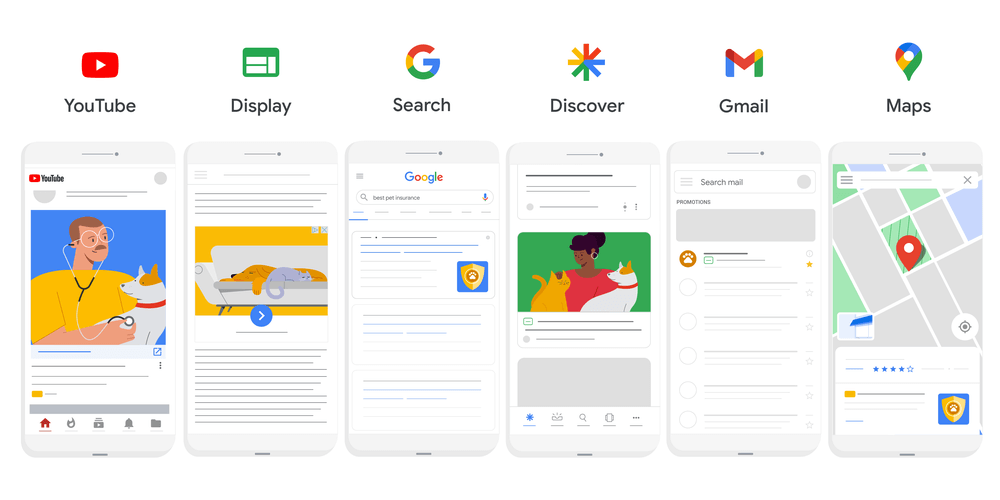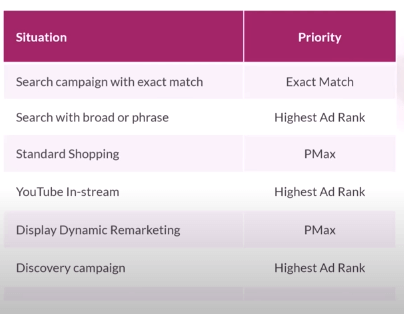Complete guide on Data-driven approach to Success with Performance Max Campaign
 Contents
Contents
- What is Performance Max Campaign?
- Key Features of Performance Max Campaign
- Pre-requisites of Performance Max Campaign
- Best Structure of Performance Max Campaign
- Providing the right signals
- Audience signal
- Assets
- Listing Group
- Bidding Strategy
- Reporting in the Performance Max campaign
- Compared to Other campaigns
- Conclusion
What is Performance Max Campaign?
As defined by Google
“Performance Max is a new goal-based campaign type that allows performance advertisers to access all of their Google Ads inventory from a single campaign. It’s designed to complement your keyword-based Search campaigns to help you find more converting customers across all of Google’s channels like YouTube, Display, Search, Discover, Gmail, and Maps.”
It is a one-campaign that serves ads on all of the Google ads inventory with limited inputs from the advertiser. The good thing is one campaign serves all inventory, the bad thing is there is a lot of junk inventory in Google that at times affects performance.
The best time to launch this campaign is when you have sufficient data on conversions, leads being fed to Google from other campaigns
Key Features of Performance Max Campaign
Here are the most important ones
- It’s a goal-based campaign that can be optimized for sales, leads, or other custom conversion-focused objectives (It works best for eCommerce not so much for B2B)
- Since the launch of this campaign, Smart-shopping campaigns have been phased out, essentially an upgrade to them
- Serves on all Google ads inventory from search, and shopping to YouTube and displays in one-campaign
- Only Automated bidding strategies are available in the campaign, hence need data inside the account before the launch
- It thrives on Audience signals and account data hence providing the most optimal data.
- Unlike traditional campaigns, Performance Max relies heavily on assets like images, videos, and text. Google’s AI then mixes and matches these assets to create ads tailored for different channels and audiences, optimizing for performance.
- The reporting part is a bit gray as Google conceals a lot of reporting (lately though it has started releasing new updates for it) and only a limited information on listing groups, assets, and search terms is available, the biggest part hidden is the served inventory data
Pre-requisites of Performance Max Campaign
If all of the below are not satisfied, then please fix that before starting this PMax campaign
- Make sure search ads are working properly and delivering results for you
- There is already at least 30 to 45 conversions (purchase, converted lead) in the last 30 days
- A well-optimized feed data with products listed and active
- Assets created for the products to be advertised. It includes videos, images, logo, headlines, descriptions
Here are 4 reasons why brands struggle with performance max campaign
Best Structure of Performance Max Campaign
This is specifically for eCommerce stores with feed and product data
Campaigns can be structured based on
- Product/Category type
- Sell-through rate
- Bestsellers or non-bestsellers
- AOV or Margins based
- Season based
- Offer based
At Bharat Mavens repeatedly seen product/category type work best with a campaign structure that is simple but effective for most brands
- 1 Campaign for the best-seller category
- 1 Campaign with multiple asset groups targeting other categories
- If need be 1 Campaign dedicated to top products
Asset groups in PMax are equivalent to ad groups in search ads, they can be segmented based on
- Type of audience you want to attract, if two different products have the same audience then go ahead
- AOV or Margins based
- Assets being used are what type
- Product or Category type
Providing the right signals
#1 Audience signal
Multiple places you can use to provide the best audience data
- Search terms report search and shopping campaigns they use those search terms to create custom segments
- Create a custom segment based on keywords in the insights tab
- Use custom Google ads tag and GA data, upload a customer list
- Use the insights tab to target particular interests
- Utilize competitor websites in custom segment
- Exclude low-level income demographics
- Google keyword planner to find relevant search terms
- If you have a PMax campaign already running then go to the insights tab > Interests and use those interests in audience targeting
#2 Assets
- Images, Videos
Most campaigns are to acquire new customers so include visual assets that highlight a pain, mention offers, talk about the USP of the product, call out a particular audience segment that is readable on a mobile screen, avoid too much text
As for videos a simple structure of pain – solution – benefits – CTA works well but it is the message inside it that makes all the difference - Text assets
Every headline, and description must work standalone, it must provide enough information about the product as only 1 or 2 of them will be visible at any given time to the audience hence it should convey the product
You have to note this campaign has a bad habit of creating its own assets like videos if none are provided and hence use this script to avoid it.
#3 Listing Group
- A completely optimized Google Merchant Centre feed is a basic necessity
- Make use of custom labels to segment the products effectively as it otherwise becomes difficult to analyze and manage
#4 Bidding Strategy
There are two types available in the campaign
- tCPA – Target Cost Per Action
If all the products in a given PMax campaign have the same CAC target go with this bidding approach - tROAS – Target Return on Ad Spend
If there are varying conversion values and CAC targets, go with this bidding strategy
Bid high for new customers?
We have tested this for multiple brands & it hasn’t been effective. If you have an excess ad budget please test it, otherwise, you can ignore
The setup of the Performance Max campaign is beyond the scope of this article, so please refer to this official Google Ads Documentation
Reporting in the Performance Max campaign
Google provides some good reports, the main ones are
- Asset group reporting
This includes data on what headlines, descriptions, images, and video assets performed. It does not give all numbers but a score of low, good, best - Listing Group or Product-type reporting
This is the holy grail where most optimization regarding adding products, excluding, and moving to other campaigns take place - Performance max placement reporting
This is the grey data as here Google provides only impressions of placements and no other metrics thrust you never know which placements performed well and which did not
Compared to Other campaign
Performance max campaign takes priority over almost every other campaign except an exact-match bidding search ads
Even in phrase-match and broad-match bidding, it is determined by Ad rank
Here is a quick summary table from God Tier Ads

Source YouTube – God Tier Ads
As you see PMax takes priority over shopping campaigns, it is important to run a shopping campaign alongside PMax as it helps increase the impression share and hence conversions
There is no final verdict on whether shopping performs better or PMax as we have seen both works separately for different accounts even though in the same niche. So you gotta test and decide.
BONUS – Quick Bites
- If you are observing consistently low CPC (way lower than other campaigns) campaigns likely reaching low-quality audiences generate a PMax placement report and exclude them
- This campaign has a bad habit of showing the wrong site link, so make sure to include right site link while creating the asset groups
- Increase the budget to an extent where the campaign isn’t utilizing the full budget, if it is then improve your ROAS/CPA targets
- Be patient, this isn’t Facebook don’t make changes often instead wait for the algorithm to understand the audience and the creative input provided. Approx 7 to 10 day time period is required, for a larger catalog even more
Conclusion
In summary, Performance Max campaigns represent a significant leap forward in Google ads but they have been restricted in providing the best performance for eCommerce products only
Since Smart Shopping campaigns are out, Performance Max is stepping up as the new go-to option. It’s all about setting your goals, feeding in some audience hints, and letting Google’s smart bidding do its thing. This makes managing ads easier and can lead to better results.
Remember, the journey into Performance Max is not just about adopting new technology; it’s about embracing a fundamental mindset in digital advertising—one that’s data-driven, user-centric, and relentlessly focused on optimization for better results.







1 Comment